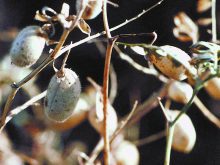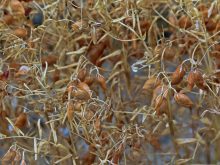Farmers can get away with driving fast and spraying big drops when using fungicide to control fusarium headblight in wheat.
That was the surprising conclusion two experts shared at the Third Canadian Workshop On Fusarium Headblight.
“Big drops, fast travel speeds and angled nozzles are your ticket,” said Tom Wolf of Agriculture Canada in Saskatoon in an interview during the conference.
This conclusion flies in the face of what most producers consider good practices when spraying, but Wolf and Ontario Agriculture’s Helmut Spieser told the conference fungicide spraying is different from applying herbicides.
Read Also

Message to provincial agriculture ministers: focus on international trade
International trade stakeholders said securing markets in the face of increasing protectionism should be the key priority for Canada’s agriculture ministers.
Fungicides are farmers’ only in-crop protection against fusarium, which threatens wheat heads when they are flowering. If the weather is warm and humid, fusarium spores from the soil can reach the flowering wheat head and infect it.
To work effectively, the fungicide needs to coat the front and back of the wheat head, because the fungus will attack any untreated area.
Since only the head is vulnerable, there’s no point spraying a fine mist that will reach most of the plant. That’s why fungicide spraying for fusarium is radically different from most other types of spraying.
“Anything that doesn’t hit the head is wasted product,” said Spieser, who has been experimenting with various spraying methods for three years.
The best method of hitting the wheat head and getting full protection is to use a double-headed nozzle, with one head facing directly forward and one facing backward. The forward-facing nozzle shoots the fungicide horizontally into the wheat heads, rather than dripping it down, which would cause much of it to hit the soil, or creating a thin mist that could simply dissipate.
The back-facing nozzle head will hit some of the wheat heads on the opposite side and an aerodynamic turbulence will catch the drops and allow the spray to “wrap around” the rest of the wheat head.
However, this approach works only if the nozzle is shooting large drops. Wolf said a mist will lose its velocity within inches of being shot out of the nozzle and will simply drift with the prevailing wind, coating only the side of the wheat head facing the wind.
He said forward spraying actually works better at speeds faster than the usual eight km-h because the sprayer’s speed adds to the forward velocity of the fungicide and will keep the droplets going straighter, increasing their chances of hitting the head.
“We found (16 km-h) to be better than (eight km-h),” said Wolf. Spieser said applications at 19 km-h also worked well.
Fast fungicide spraying is also a good idea because producers have so little time to react when disease conditions are ripe. If heat and humidity hit danger levels during flowering, farmers can’t afford to spend a whole day spraying one quarter section, Wolf said.
Spieser added that some farmers despise double nozzle heads because they are expensive and known for malfunction. Some double nozzles cost more than $30 each, compared to the $10 price tag of most single nozzles.
They can also get knocked out of alignment by tall plants in the canopy, and can be hard to fit into multi-head nozzle holes.
“Producers don’t like them,” Spieser said.
Because of this antipathy, Spieser has also been testing forward-facing single head nozzles.
The best, the Turbo FloodJet, “worked well, but it was highly variable coverage.”
Without the double head’s backward facing nozzle, the Turbo FloodJet soaked some heads perfectly, but achieved poor coverage on others.
Wolf said he did not want to take a stand on whether ground or aerial spraying worked better, but he added many farmers who begin with ground spraying also end up bringing in the planes.
“That’s the reality Ð the time pressure is enormous,” he said.















